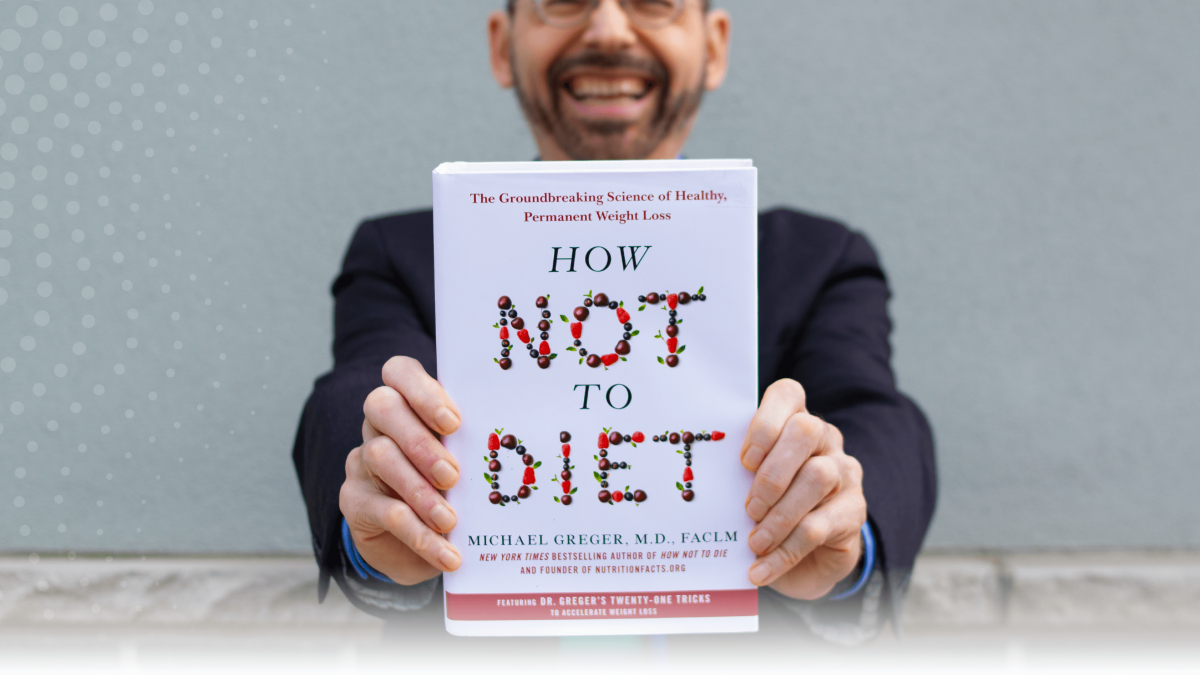Dancers can feel like their weight is a tricky balance between staying toned but also having tremendous energy and strength. Being too thin can increase injury risk, decrease energy and power performance. Do dancers need to diet? My response as a former professional dancer myself and as a dietitian who has worked with some of the best dancers in the field over the past 10 years is no! Diets not only don’t work, but they cause more problems than they solve.
I’m particularly concerned about the dangers with paleo, intermittent fasting, keto and all the low carb diets. Here, I review the new anti-diet book, How Not to Diet, by Dr. Michael Greger, which expertly lays out the research on why diets don’t work and how eating more, not less, is the answer to weight loss and weight management. It’s 570 pages, so here are my top takeaways for dancers.
It’s all about fiber.
Worrying about cutting carbs is so 1990 and hasn’t worked. People would do much better to focus their energy on getting more fiber and eating carbs from whole grains, legumes, fruits and vegetables, as opposed to refined grains and baked goods. Fiber is found exclusively in plant foods. High fiber foods are foods like beans, peas, oats, mangoes, berries, whole wheat, quinoa, broccoli, avocados and leafy greens. Yes, it’s true that there are different kinds of fiber. The main point is that the body needs these different types in way higher amounts than most westerners currently get, and fiber helps promote fullness, supports good gut bacteria associated with lower weight and also can reduce the amount of dietary fat actually absorbed.
Greger writes that our “food industrial complex led to a glut of cheap, ready-to-eat, low cost but high calorie foods willfully engineered with chemical additives to be hyperstimulatingly sweet or savory yet only weakly satiating.” Leading to it being almost impossible to not overeat these low fiber, low nutrient foods. Taste buds and taste preferences change over time, so when we shift the focus to fruits, vegetables, whole grains, plant-based proteins and moderate portions of nuts and seeds, we adapt to actually crave those whole natural foods. It’s amazing how sweet a mango is when you stop bombarding your taste buds with refined sugar and artificial sweeteners. A bowl of beans, rice, veggies, greens and avocado can be incredibly filling and nutritious.
“Telling people to increase their intakes of fiber-rich foods may actually be one of the single most effective pieces of advice for weight loss,” according to Greger. Think about what you fill your fridge and pantry with. If a person is transitioning from a low fiber diet to a high one, it might take the body a few weeks to adjust.
Portions
Traditional diet advice focuses on what not to eat or making people watch their portions. It’s true that portion sizes of most fast food, beverages and sweets have grown more than 30 percent in one generation, and this contributes to our obesity epidemic. Greger’s advice is eat as much as you want of high fiber, whole minimally processed, plant-based foods. Instead of restricting, and thus feeling hungry and deprived, fill up on fiber, high-water content foods, fruits, veggies, beans, lentils, peas, soy and whole grains. Minimize the refined grains, baked goods, high-calorie coffee drinks, meat, dairy, sugar and sweetened beverages in your day-to-day. This is what leads to weight loss and long-term weight management, not deprivation. Having these occasionally won’t ruin a good eating plan, but having them every day is something to consider changing. Don’t try to be perfect; that will only backfire. Aim to make smart changes that you can stick to long-term.
High protein doesn’t equal long-term weight control.
Focusing on eating protein particularly from meat and dairy while depriving oneself of carbs doesn’t lead to long-term weight loss, according to years of large sample size studies. High animal protein diets aren’t shown to promote weight loss over time unless people stick to a very restrictive, low-calorie diet long-term, which is incredibly hard to do and increases inflammation and risk for long-term diseases like heart disease and diabetes.
Not all sugar has the same effect on the body.
Yes, it’s true that all sugar regardless of if it’s jelly beans or an apple has four calories per gram. Sugars are carbohydrates, but the effects on the body from eating an actual whole apple vs. apple juice or sugary beverage is very different. Don’t fear the sugar from fresh and frozen whole fruits. Minimize refined and added sugars.
Water
“The biggest influence on calorie density is not fat but water content,” Greger says. Adding extra portions of vegetables and prioritizing vegetables first increases the vitamin, mineral and phytonutrient content of the food and decreases the calories without leaving you hungry. This could be as simple as adding a big salad to start dinner or pureeing vegetables like cauliflower, squash, tomatoes, zucchini, leafy herbs and greens into pasta sauce in place of cheese, cream or oils. This can decrease calories by 25 percent while increasing the nutritional value and being less inflammatory. Mushrooms, beans and lentils are good examples of high-fiber plants that can be used to replace all or part of meat in a meal or sauce.
Adding chopped greens like kale, chard or spinach as a topping to soups also increases weight loss by adding food and fiber and also because soup has been shown to be more satiating than the same meal in solid form. We tend to eat pureed veggies in soup, for example, slower, and eating more slowly is one of Greger’s tips for managing weight. While blended fruit in a smoothie might also provide fiber and be filling, it’s not as filling as soup because we tend to slurp our smoothies down quickly. Taking more time to eat makes a difference. This can also be true of chewing food more intentionally and more slowly. “Asking people to chew 50 percent more times than normal may cut consumption of food by 10 percent,” he says, while also improving digestion.
Weight loss boosters
A key concept from this book is to get more sleep (at least seven to eight hours) and avoid late-night snacking. Eat a big breakfast, good lunch and moderate dinner. Dinner should meet your protein and energy needs to refuel after a hard day, but it shouldn’t be your biggest meal, according to Greger.
Obviously, his research didn’t include professional dancers who have shows that end at 10pm and who must eat after their shows, so dancers should always have a good dinner even if they work later. He is talking about mindless late-night snacking. Those who stayed up later at night tended to eat unnecessary calories after dinner was already finished when our circadian rhythms are less equipped to deal with those calories. The same snacks eaten mid-morning would be metabolized by the body differently and less likely to be stored as fat because of these circadian rhythms.
Greger writes extensively about circadian rhythms, which fits nicely with my own advice for dancers to eat a big breakfast and make sure they’re providing adequate energy intake during their day. Greger also cites weight loss boosters such as drinking green and hibiscus teas, using cinnamon and ginger, and of course getting plenty of non-sweetened water throughout the day.
Criticisms
Overall, this book is a wealth of research and good diet advice. My criticisms of How Not to Diet are only that it could be triggering for those with eating disorders. I would never recommend that dancers weigh themselves every day, and I caution dancers to remember that they are elite athletes and have higher energy and protein needs than average people. Dancers with food allergies or intolerances should consult with a registered dietitian.
Putting it into practice: One example from a real client
Melody* seeks nutrition counseling for a nine-pound weight gain over her ideal dancing weight. She states that she “avoids carbs and doesn’t know where to begin.”
Her previous eating routine includes:
7am: 2 eggs cooked in 1 small pat of butter with a small handful of almonds
No morning snack
12pm: Turkey sandwich on 2 slices of white bread, 1 Tbs mayonnaise, 1 cup carrot sticks and snack size bag of chips
3pm snack: Fast food grilled chicken salad (avoids eating French fries and no sugary soda)
9pm: Very hungry when gets home, eats “a little bit” of chocolate chip trail mix while making dinner with 3 oz salmon, asparagus cooked in olive oil and a side salad with low fat dressing. But she’s still hungry.
10pm: Stays up late finishing up work and eats more trail mix.
She’s only getting 5-6 cups of water per day, which is not enough.
Dietitian’s comments:
Many of Melody’s choices are not bad, but she could make tweaks for improvement, starting with the trail mix. She’s currently getting 1,947 calories, which is fine for her energy levels, but she’s getting 117 grams of fat and 457 grams of cholesterol with only 16 grams of fiber. So this isn’t a calorie issue; she doesn’t need to start restricting or extreme dieting. She needs to cut back on dietary fats and increase her fiber from plant-based foods. She needs to increase her water intake by about 4-5 more cups than she was getting. She needs to minimize the late-night snacking, especially on calorically dense foods like trail mix. Most of my dancer clients need about 35-50 grams of fat per day, and at least 30-50 grams of fiber. Greger suggests that the human body evolved to eat double that amount of fiber. She does not need to increase her protein. She’s already getting 97 grams, which is significantly more than the ~65-70 grams she needs. More protein doesn’t magically make the body lose stored body fat. This myth that people need to increase protein to lose weight doesn’t hold up in the research.
Here’s how Melody lost the weight by eating more volume of food, not less:
7am: 1-1.5 cups cooked oatmeal with ½-1 cup berries or other fruit, sprinkle slivered almonds or seeds, and 1 cup calcium fortified almond or soy milk
10am: 1-1.5 cups grapes or other fruit of her choice (whole fruit, not juice)
12pm: 1 cup beans and rice with a large salad with tons of veggies, toasted quinoa, more slivered almonds (or pumpkin seeds) and low fat dressing
3pm: Peanut butter and jelly sandwich on whole grain bread, carrots and an apple
5pm: Small Bobo’s Oat bar during break
8:30pm: 1.5 cups cooked lentil flour pasta with marinara sauce with added blended veggies such as carrots, cauliflower, basil and/or zucchini. Topped with 1 cup steamed broccoli
10pm: 1-2 cups light popcorn or watermelon. Worked on managing late-night snacking or at least making better choices at night.
2 cups of water before every meal and a 32 oz water bottle with her all day that gets refilled 2-3 times per day. No sugary beverages and no artificial sweeteners.
Her new dietary plan gave her 1,894 calories, 41 grams of fat, 3 grams cholesterol, 77 grams protein and an excellent 66 grams of fiber. She took a B12, D3, calcium and other vitamins specific to her needs based on her nutrition assessment. We made sure she was getting enough calcium and iron. She wasn’t hungry but she still lost weight at a slow, steady pace. She went on to reach her goal weight, and then we put her on a maintenance plan that actually allowed her even more food and have occasional treats. She got a contract with a modern dance company outside of New York.
*name changed for privacy
Sources:
Greger M. How Not to Diet: the groundbreaking science of healthy, permanent weight loss. Flatiron Books NY, 2019.
By Emily C. Harrison MS, RD, LD of Nutrition for Great Performances.
Emily Cook Harrison MS, RD, LD
Emily is a registered dietitian and holds both a bachelor’s and master’s degree in nutrition from Georgia State University, USA. Her master’s thesis research was on elite level ballet dancers and nutrition and she has experience providing nutrition services for weight management, sports nutrition, disordered eating, disease prevention, and food allergies. Emily was a professional dancer for eleven years with the Atlanta Ballet and several other companies. She is a dance educator and the mother of two young children. She now runs the Centre for Dance Nutrition and Healthy Lifestyles. She can be reached at emily@dancernutrition.com
www.dancernutrition.com















